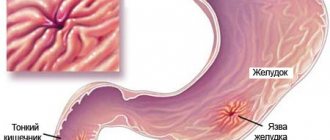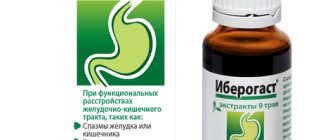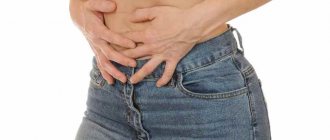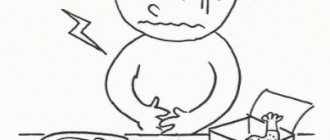The most common cause of stomach pain is the food we eat. Irritation of the esophagus (pressing pain) is caused by salty, too hot or cold food. Certain foods (fatty, cholesterol-rich foods) stimulate the formation or movement of gallstones, causing attacks of biliary colic. It's no secret that many people are intolerant to certain foods, such as milk, milk sugar or lactose. Eating them leads to cramping abdominal pain, bloating and diarrhea.
Early abdominal pain is characteristic of ulcers of the upper stomach and occurs half an hour to an hour after eating. They gradually intensify as the concentration of hydrochloric acid in the stomach increases. Over time, food moves from the stomach to the duodenum, the acidity of the gastric contents drops and after 1-2 hours the abdominal pain decreases.
Nature of abdominal pain and connection with food intake:
Late abdominal pain occurs 1.5-2 hours after eating. They are also characteristic of chronic pancreatitis. — Hunger pain in the stomach occurs 5-6 hours after eating. They decrease or stop after the patient drinks milk or eats. - Night abdominal pain is similar to hunger pain; it occurs at night. Night and hunger pains occur during an ulcerative process in the duodenum.
What diseases cause pain after eating:
The main causes of pain after eating:
1. With a stomach ulcer, pain also occurs after eating, but no later than 1-1.5 hours after eating. Early stomach pain is characteristic of ulcers of the upper stomach and occurs half an hour to an hour after eating. They gradually intensify as the concentration of hydrochloric acid in the stomach increases. Over time, food moves from the stomach to the duodenum, the acidity of the gastric contents drops and after 1-2 hours the abdominal pain decreases. With a stomach ulcer, the pain is localized on the left side or along the midline of the abdomen, in its upper part. If the patient has a duodenal ulcer, pain occurs to the right of the midline. Sometimes the pain can be retrosternal or radiate to the back. The nature of the pain can be very diverse. In a third of patients, abdominal pain is very severe. For the most part, they are dull, aching, or drilling, stabbing, cramping.
2. With a pyloric canal ulcer, pain appears 1-1.5 hours after eating.
3. When the ulcer is localized in the duodenum, late pain usually occurs - later than 1.5-2 hours after eating.
4. With chronic gastritis, there is usually an early onset of pain - almost immediately after eating, especially if the food is coarse and sour. Depending on the level of acidity of gastric juice, heartburn, sour belching, constipation, or nausea, belching with an unpleasant odor, flatulence, bloating, and diarrhea may occur. The pain can be of different types: pulling, pressing, burning, cutting. This also depends on many factors: stomach filling, the presence of cramps, acidity, individual reaction to foods and others.
5. Inflammation of the mucous membrane of the stomach and the duodenum directly extending from it is called gastroduodenitis. This disease is long-term. It either intensifies or subsides. It is characterized by periodic pain, varying in strength and duration, which is localized “in the pit of the stomach” and around the navel. Abdominal pain usually occurs after eating. They are accompanied by a feeling of fullness and heaviness in the upper abdomen. Belching sour, less often rotten.
6. Pylorospasm is a spasm of the pylorus or pylorus, which is located at the transition of the stomach to the duodenum. This condition most often occurs in patients with neuroses. After eating or some time after eating, abdominal pain occurs in the epigastric region and profuse vomiting. In this condition, patients may experience significant weight loss, since food simply does not have time to be absorbed.
7. Inflammation of the gallbladder and biliary tract: inflammation of the gallbladder (cholecystitis) or biliary tract (angiocholitis), as well as disruption of their function (dyskinesia) often causes pain in the abdomen, especially in the area of the right hypochondrium. Pain occurs after eating fatty, heavily overcooked foods, fatty sweets - halva, chocolate, ice cream, etc.
8. Pancreatitis. A constant and leading symptom is pain after eating, most often constant, dull or cutting, as the disease develops it increases to severe pain, sometimes leading to shock, is localized high in the stomach, in the right or left hypochondrium, and when the entire gland is affected, it is encircling in nature.
9. People suffering from irritable bowel syndrome are characterized by the appearance of pain immediately after eating, which is accompanied by bloating, increased peristalsis, rumbling, diarrhea or loss of stool. The pain subsides after defecation and passage of gases and, as a rule, does not bother you at night. The pain syndrome of irritable bowel syndrome is not accompanied by weight loss, fever, or anemia.
10. Pain after eating is typical for stomach cancer, but other signs of an oncological process in the body should be taken into account: - Unexplained weight loss and lack of appetite. - Stomach ache. - Unpleasant sensations (discomfort) in the abdomen, often above the navel. - Feeling of fullness in the stomach after eating a small amount of food. - Heartburn, indigestion, or ulcer-like symptoms. - Nausea. - Vomiting with or without blood. — Increase in the size of the abdomen — Increasing pallor of the skin.
This characteristic of the pain syndrome has very important diagnostic significance. First of all, it is necessary to pay attention to the connection between pain and food intake and the nature of the food taken. Foods with a high alkaline buffer capacity (boiled meat, dairy products, except fermented milk) cause pain to appear later. Rough plant foods, vegetable marinades, brown bread, and canned food cause pain to appear earlier. The so-called early pain can cause the patient to fear before eating. Patients begin to refuse food. A different picture is observed in patients suffering from duodenitis and duodenal ulcer. Their pain is “hungry”, nocturnal in nature and is relieved by taking liquid (milk) or soft (porridge, mashed potatoes, minced meat or fish) food, and drinking soda.
Peptic ulcer
Peptic ulcers develop and worsen when the protective lining of your stomach fails to protect it from the acid the stomach uses to digest food. An ulcer can usually be recognized by pain in the left upper quadrant of the abdomen or the upper central part of the abdomen. This pain begins within about two hours after eating. It is described as a sharp or nagging pain, sometimes radiating to the back. The pain of an ulcer can be quite painful, especially if it deepens enough to perforate the stomach lining.
Gallstones
Gallstones can be recognized by cramping pain in the right upper quadrant of the abdomen, usually for several hours after eating. Fatty foods worsen abdominal pain after eating. It is worth knowing that obese people and overweight women are more likely to have gallstones. Gallstone pain is often accompanied by nausea and vomiting and can radiate to the area around the right side of the body and to the back. It is important to note that some types of abdominal pain may improve with changes in posture and physical activity, but gallstone pain continues to bother a person no matter how much physical activity you do.
Mesenteric (intestinal) ischemia
Intestinal ischemia occurs when cholesterol plaques grow in the arteries, impairing blood flow to the intestines. Stronger blood flow to the intestines is necessary after eating. If your arteries are clogged, eating can speed up and worsen the pain, especially if there is insufficient blood supply to the intestines. Pain during mesenteric ischemia is usually diffuse, and is usually accompanied by fear of eating. Patients are afraid to eat and lose weight.
Other causes of stomach pain after eating
There are many reasons for severe abdominal pain after eating. Some of these include celiac disease, which can be recognized by bloating and discomfort after eating foods containing gluten. Gluten is a protein found in wheat, rye and barley. Abdominal pain after eating is also affected by lactose intolerance. It can be recognized by discomfort and diarrhea after eating lactose, and bacterial food poisoning. They are characterized by cramping abdominal pain several hours after eating, especially if it contains mayonnaise.
In this section we will talk about why your stomach hurts after eating.
.
The most common cause of stomach pain is the food we eat. Irritation of the esophagus (pressing pain) is caused by salty, too hot or cold food. Certain foods (fatty, cholesterol-rich foods) stimulate the formation or movement of gallstones, causing attacks of biliary colic.
It's no secret that many people are intolerant to certain foods, such as milk, milk sugar or lactose. Eating them leads to cramping abdominal pain, bloating and diarrhea.
Early abdominal pain is characteristic of ulcers of the upper stomach and occurs half an hour to an hour after eating. They gradually intensify as the concentration of hydrochloric acid in the stomach increases. Over time, food moves from the stomach to the duodenum, the acidity of the gastric contents drops and after 1-2 hours the abdominal pain decreases.
With a stomach ulcer, the pain is localized on the left side or along the midline of the abdomen, in its upper part. If the patient has a duodenal ulcer, pain occurs to the right of the midline. Sometimes the pain can be retrosternal or radiate to the back. The nature of the pain can be very diverse. In a third of patients, abdominal pain is very severe. For the most part, they are dull, aching, or drilling, stabbing, cramping.
Nature of abdominal pain and connection with food intake:
- Late abdominal pain occurs 1.5-2 hours after eating. They are also characteristic of chronic pancreatitis.
- Hunger pain in the stomach occurs 5-6 hours after eating. They decrease or stop after the patient drinks milk or eats.
- Nocturnal abdominal pain is similar to hunger pain; it occurs at night. Night and hunger pains occur during an ulcerative process in the duodenum.
What diseases cause abdominal pain after eating and why does the stomach hurt after eating
:
- Stomach ulcer.
- Peptic ulcer of the duodenum.
- Inflammation of the mucous membrane of the stomach and the duodenum directly extending from it is called gastroduodenitis. This disease is long-term. It either intensifies or subsides. It is characterized by periodic pain, varying in strength and duration, which is localized “in the pit of the stomach” and around the navel. Abdominal pain usually occurs after eating. They are accompanied by a feeling of fullness and heaviness in the upper abdomen. Belching sour, less often rotten.
- Pylorospasm is a spasm of the pylorus or pylorus, which is located at the transition of the stomach to the duodenum. This condition most often occurs in patients with neuroses. After eating or some time after eating, abdominal pain occurs in the epigastric region and profuse vomiting. In this condition, patients may experience significant weight loss, since food simply does not have time to be absorbed.
- Inflammation of the gallbladder and biliary tract: inflammation of the gallbladder (cholecystitis) or biliary tract (angiocholitis), as well as disruption of their function (dyskinesia) often causes pain in the abdomen, especially in the area of the right hypochondrium. Abdominal pain occurs after eating fatty, heavily overcooked foods, fatty sweets - halva, chocolate, ice cream, etc.
- Pancreatitis. A constant and leading symptom is abdominal pain after eating, most often constant, dull or cutting, as the disease develops it increases to severe pain, sometimes leading to shock, is localized high in the pit of the stomach, in the right or left hypochondrium, and if the entire gland is affected, it is encircling in nature. .
- People suffering from irritable bowel syndrome typically experience abdominal pain immediately after eating, which is accompanied by bloating, increased peristalsis, rumbling, diarrhea, or loss of stool. The pain subsides after defecation and passage of gases and, as a rule, does not bother you at night. The pain syndrome of irritable bowel syndrome is not accompanied by weight loss, fever, or anemia.
Remember if you have constant or occasional stomach pain after eating
, immediately contact us for
Abdominal pain is one of the most common complaints with which patients come to see their local doctor. Pain syndrome can vary in severity and intensity, and can also have an acute or chronic course. Chronic pain is usually milder compared to acute attacks, since the existing inflammatory processes at this stage enter the attenuation stage. To diagnose the causes of the pathological condition, the time of onset of pain is also important: it can appear after physical activity, sexual contact, lifting heavy objects or eating.
If a person has a stomach ache after eating, the reasons may be different, but in most cases they are associated with disturbances in the functioning of the digestive system. It is possible to accurately determine the cause of the pain syndrome only after contacting a gastroenterologist, who will prescribe an examination and laboratory diagnostics to identify signs of the inflammatory process and assess the state of the human immune system.
Food poisoning is the most common cause of sudden pain in the epigastrium, which occurs 10-30 minutes after eating. The main source of infection are foods containing large amounts of protein, which accumulates in the muscle tissue of animals. These are all types of meat and fish, poultry, eggs, dairy products. You can suspect poisoning in a person with severe abdominal pain if he has consumed the following food groups:
- canned food that was stored in dented and swollen jars;
- expired products;
- pies, salads and other dishes sold on the street;
- charcoal smoked fish;
- dairy products with an uncharacteristic (very sour) odor;
- dark-colored meat with charred edges.
The pain in case of poisoning is acute, concentrated in the center and lower part of the abdomen, after which it spreads throughout the entire abdominal cavity with a predominant localization in the epigastrium and abdominal space. Painful sensations are caused by intestinal spasms and can take on a paroxysmal nature. The patient's temperature rises (in case of severe poisoning, above 39°), fever and chills appear. Within 30-40 minutes after consuming a low-quality product, uncontrollable vomiting begins, usually multiple times, without bringing relief.
A characteristic symptom of food poisoning is diarrhea. The stool has a foul odor and a watery consistency with a lot of foam. The color of the stool is yellow or light brown. If greens appear in the stool, it means that pathogenic flora begins to actively develop in the intestines, and the patient requires urgent medical attention.
Important!
For any poisoning, a person needs to be hospitalized in a hospital.
Severe dehydration, which occurs as a result of excessive fluid loss due to frequent vomiting and diarrhea, can lead to death. To avoid this, it is necessary to give the patient a warm salt drink (small sips). You can use ready-made medications, for example, " Regidron
".
Before the ambulance arrives, it is necessary to perform gastric lavage and give the person any sorbent drugs (“ Smectu
”, “
Activated carbon
”, “
Polysorb
”).
What are the reasons for stomach pain?
When your stomach starts to hurt while eating, you need to think about what you are eating.
Often the cause is the consumption of spicy, irritating foods, alcoholic, carbonated and energy drinks. Undernutrition or overconsumption of food also affects stomach health. Irrational diets have a negative impact on the entire body, and their constant adherence and desire to meet a fictitious standard at all costs can lead not only to anorexia, but also gastritis, and possibly an ulcerative process.
Overeating leads to severe distension of the stomach. Such careless attitude towards oneself affects not only the stomach, but also other organs of the digestive system: the pancreas, liver, gall bladder, which work under conditions of increased stress.
Stressful situations are an important factor in the development of functional gastralgia. The formation of functional dyspepsia, as a rule, occurs against the background of psycho-emotional stress - mental trauma.
What diseases can cause stomach pain:
- gastritis;
- ulcerative formations;
- gastroenteritis;
- gastroesophageal reflux disease (GERD);
- hiatal hernia;
- stomach neoplasms.
Pathologies of other organs that may manifest as radiating pain to the stomach area:
- acute myocardial infarction of the posterior and inferior wall of the left ventricle;
- gallbladder diseases: cholecystitis, cholelithiasis;
- pancreatitis - inflammation of the pancreas, especially in the head and part of its body.
Lack of digestive enzymes
Lactase deficiency is a form of enzyme enteropathy in which the human body does not produce enough lactase. Lactase is a type of protein that is necessary for the digestion and breakdown of milk sugar. Some people mistakenly call the pathology lactase deficiency. This is incorrect because lactose is the sugar contained in milk, and lactase is a type of digestive enzyme.
Lactase deficiency is usually diagnosed in childhood (in infants under 1 year of age). The pathology is physiological in nature and disappears when the child reaches 6-8 months of age. Such disorders are temporary and are associated with the immaturity of the child’s digestive system.
In adults, lactase deficiency appears in approximately 10-13% of cases - here we are talking about a congenital disorder, which, if left untreated, can lead to malabsorption syndrome. This is a pathological condition in which the absorption and assimilation of essential elements is disrupted: vitamins, acids, mineral elements, lipids, carbohydrates and protein.
A typical symptom of the disease at any age is abdominal pain, which occurs after drinking cow's milk and dishes containing it. Pain syndrome may be accompanied by other symptoms, including:
- bloating;
- the release of a large amount of odorless gases and subsequent relief;
- low body weight;
- pale skin;
- signs of anemia during blood tests (low hemoglobin).
Important!
Chronic lactase deficiency if left untreated can lead to very serious consequences: osteoporosis, anemia, muscle tissue atrophy, visual impairment, endocrine diseases.
In children, pathology increases the risk of developing rickets and retardation in mental and physical development, so it is important not to ignore painful sensations and start treatment on time, which includes taking the digestive enzymes lactase (the drug " Lactazar
").
Nature of pain
Based on patient complaints, doctors identify several types of abdominal pain that bother a person after eating. They are:
- Acute pain that occurs when the body is affected by food poisoning. It also happens that such sensations appear as a result of human exposure to heavy metals or radiation. This type of pain can also occur with constipation, excessive food intake, severe stomach strain, or injuries to the esophagus or intestines.
- Burning pain occurs in a person who does not eat properly and is addicted to spicy and fatty foods. This is explained by the fact that such foods produce additional acid, which damages the gastric walls. It is worth considering the fact that it is precisely this diet that can provoke the appearance or exacerbation of gastritis or gastric and duodenal ulcers.
- Nagging pain may be the result of an allergy to any product or the result of poor nutrition. This problem is especially common in patients who are addicted to semi-finished products and baked goods.
- Mixed and wandering pain indicates that a person has several pathologies at the same time.
Very often, abdominal pain after eating can be accompanied by the following unpleasant symptoms: nausea, bloating, constipation, decreased appetite, increased gas, diarrhea, heartburn or belching.
These symptoms are provoked by the following factors:
- Eating food before bed.
- Wrong diet.
- Bad habits: smoking tobacco and drinking alcohol.
- Absorption of excessively dry food.
- Hot spices.
- Non-compliance with food intake.
- Quick absorption of food (snack on the go).
- Binge eating.
Experts strongly recommend drinking more fluid, which supports the functioning of all organs and removes harmful substances from the body.
Chronic intestinal inflammation
Abdominal pain that appears several hours after eating food may be a sign of chronic colitis, a pathology in which the sigmoid colon and other parts of the large intestine become inflamed. The pain syndrome can be sharp, cutting, pulling. Cramping pain with colitis is not so common, but sometimes such a course of the disease is possible.
A distinctive sign of the disease is diffuse pain and painful sensations in the lateral parts of the abdomen, which appear after eating food with a high content of fiber, purine and coarse plant fibers. This includes all types of legumes (lentils, beans, peas), cabbage, cucumbers, bran bread, cereals, raw apples. Drinks with added gas (champagne, lemonades), milk, chocolate and fried foods can cause pathological symptoms.
Other symptoms of the disease are:
- relief of pain after taking antispasmodic drugs and bowel movements;
- subsidence of severe symptoms after taking a hot bath or using dry heat in the abdominal area;
- stool instability;
- frequent urge to defecate, during which there is no excretion of feces;
- mucus in stool.
For the symptomatic treatment of colitis, agents that relax smooth muscles and eliminate spasms are used. These could be drotaverine preparations (“ No-shpa
", "
Drotaverine
") or "
Papaverine
". To relieve acute symptoms, it is better to combine systemic therapy with the use of local agents in the form of rectal suppositories. The patient is also prescribed a strict diet that excludes the consumption of foods containing plant fiber.
Note!
Chronic colitis, if left untreated for a long time, can cause astheno-neurotic syndrome, which causes sleep disorders, increased irritability, and anxiety. Some patients may develop phobias.
When the pain comes
The period of time from the moment of eating to the onset of pain plays an important role, since it is by this factor that one can recognize what a person is sick with. When the pain begins almost immediately, at the time of eating, problems with the esophagus and sphincter patency cannot be ruled out.
Painful sensations can appear after twenty minutes, after one, three hours, because at this time food is digested, and only then does the food enter the intestines. Here's why eating can cause discomfort:
- damage to the mucosa;
- lactose;
- fried foods;
- gluten;
- fructose from food;
- spicy food;
- alcohol.
With a peptic ulcer affecting the duodenum, pain appears after two to three hours or at night. Pain during the first hour after eating indicates diseases of the esophagus or stomach. If discomfort begins later, then the reasons lie in the intestines.
Pain immediately after eating
Abdominal toad is one of the types of atherosclerosis, in which narrowing and deformation of the blood vessels through which blood enters the gastrointestinal tract occurs. Pain with this pathology appears 20 minutes after eating and is of high intensity. Painful sensations will be stronger if the patient is prone to overeating or prefers fatty and fried foods. The nature of the pain is pressing, bursting. The pain syndrome is localized in the upper iliac region on the left side with transition to the right hypochondrium.
This type of atherosclerosis has certain signs that make it possible to distinguish it from other diseases of the digestive system. These include:
- pain relief after taking Nitroglycerin;
- short duration of the attack (in rare cases, the pain can last up to 2-3 hours);
- the appearance of beads of sweat on the forehead;
- fear of death;
- rapid pulse.
There is no specific treatment for this pathology - therapy is aimed at complex treatment of blood vessels and prevention of thromboembolism. In advanced stages, the patient may only be indicated for surgical treatment, since conservative methods will not give a positive result.
Important!
Abdominal toad is a dangerous pathology that can cause fatal diseases, such as intestinal obstruction. Another possible complication if left untreated for a long time is gastric bleeding.
Food as a cause of stomach pain
First of all, the appearance of pain after a meal should be associated with food. Their quality directly affects the functioning of organs. Stale or improperly prepared food can lead to discomfort and pain.
Too fatty and spicy dishes, which prevail on tables during the holidays, are the main cause of pain in people. They cause inflammation of the digestive organs. In combination with alcoholic products, such food can provoke an exacerbation of pancreatitis. With existing chronic pathologies of the digestive tract, any violation of the diet can cause severe pain. It is important for such patients to always follow nutritional recommendations in order to quickly cope with the disease and avoid discomfort.
Pain after dinner
Pain after eating can also be a sign of cholelithiasis or cholecystitis - inflammation of the gallbladder. With this disease, pain occurs mainly 3-4 hours after dinner and intensifies during night sleep. In the acute course of the inflammatory process, pain will be accompanied by nausea, profuse vomiting with an unpleasant odor, high fever, pallor of the skin and mucous membranes.
Pain syndrome with cholecystitis has a strict localization: in the area of the right hypochondrium with transition to the collarbone and scapula on the right side. Pathological manifestations intensify after eating fatty foods, spicy seasonings, smoked meats and pickled foods.
In case of acute inflammation, the patient must be hospitalized in a hospital. In most cases, it is possible to stop an attack and achieve positive dynamics with conservative therapy. If there is no improvement in the patient’s condition, or an ultrasound scan shows the presence of stones in the gall bladder, the patient is prescribed cholecystectomy - surgical removal of the gall bladder.
Irritable bowel syndrome (IBS)
Pain is an integral symptom of irritable bowel syndrome . In addition to this, a person is usually tormented by bloating, increased gas production, belching and alternating diarrhea with constipation. If these symptoms are familiar to you, you will have to go to the doctor. Typically, treatment for IBS comes down to the following points:
- Proper frequent meals in small portions;
- Quitting alcohol and smoking;
- Reducing stress levels;
- Taking symptomatic medications to quickly eliminate discomfort (antispasmodics, antidiarrheals, laxatives);
- Taking gastroenteroprotectors to restore the mucous membrane and completely eliminate symptoms.
Other reasons
Other pathologies of the gastrointestinal tract can also cause pain in the abdomen, which appears or intensifies after eating, for example:
- gastritis;
- pancreatitis;
- duodenitis;
- peptic ulcer of the stomach and intestines.
If a person moves little, eats a lot of unhealthy foods, tends to overeat, and experiences constant emotional stress (or is in a state of chronic stress), pain after eating may be associated with irritable bowel syndrome. The mechanism by which this pathology appears is not fully understood, but doctors name a number of reasons that contribute to the occurrence of the pathological condition. These include:
- intestinal dysbiosis;
- errors in nutrition;
- diseases of the endocrine system;
- genitourinary diseases.
Note!
Symptoms of irritable bowel syndrome begin to subside in the afternoon and disappear completely by evening. The pain bothers a person mainly after breakfast; by lunchtime its intensity begins to decrease. The age group in which this pathology is most often diagnosed includes patients aged 28 to 40 years.
Stomach ulcer
The development of a stomach ulcer causes pain in the abdominal area after eating. Soreness occurs within the first 60 minutes. At first, the pain makes itself felt with weak force, but as the stomach digests food, it intensifies, sometimes becoming unbearable. The reason for this is the increased production of hydrochloric acid necessary for digestion and the presence of damage to the gastric mucosa. After the food is digested and enters the duodenum, the pain subsides, but it will return after eating.
In the presence of a stomach ulcer, pain is localized in the central region of the abdominal cavity or on its left side. If its mucous membrane is affected, then the pain will be on the right. With an advanced disease, pain can appear in the back, but its character becomes very different. There are pains:
- sharp;
- pulling;
- cramping;
- aching.
Relationship between pain after eating and location and other symptoms
In order for the doctor to be able to determine the cause of the pain that occurs after eating, it is necessary to indicate the exact location of the discomfort. This will help to create an accurate clinical picture and make a preliminary diagnosis, as well as prescribe the necessary examinations and tests.
| Localization of pain | Characteristics of pain | Possible diseases |
| Epigastric region and anterior part of the left hypochondrium | Diffuse or strict localization of pain in the presence of ulcerative defects of the digestive tract mucosa | Gastritis, duodenitis, peptic ulcer |
| Right hypochondrium (possible transition to scapula and collarbone) | Acute intense pain, possibly paroxysmal | Gallstone disease, cholecystitis |
| Upper abdomen | The pain syndrome often takes on a girdling character | Pancreatitis |
| Area around the navel | Dull, stabbing, cutting pain, intestinal cramps | Intestinal diseases |
Video - Explanation of a neurologist about abdominal pain
To establish an accurate diagnosis, one examination and palpation of the abdomen will not be enough. The patient will be required to undergo laboratory tests of biochemical parameters of blood and urine, ultrasound of the abdominal organs, FGDS, and radiography of the peritoneum. If indicated, the doctor may send the patient for an intestinal colonoscopy - examination of the intestines using a special probe with an optical device at the end.
Abdominal pain after eating is a clinical symptom typical of many gastrointestinal pathologies. Some people make a big mistake when they begin to treat themselves on the advice of friends. It is important to understand that there are many reasons that can provoke pathology. Each of them has its own characteristics and approach to treatment.
Some drugs that are used to treat gastritis and duodenitis can be harmful in case of atherosclerotic damage to the vessels of the abdominal cavity and digestive tract, therefore, before taking any medications, it is necessary to undergo an examination and make sure that the diagnosis is correct. If this is not done, there is a high probability of serious consequences and complications, so you need to start treating any pain by visiting a specialized specialist.
Pancreatitis
This disease is caused by inflammation of the pancreas. The main signs of development are severe pain in the abdominal cavity, appearing a short time after eating. The pain can be localized in the right hypochondrium, and in very severe cases the pain becomes girdling.
This is a very serious disease that does not tolerate self-medication and delay in treatment, which can result in death. That is why at the first signs of pancreatitis it is necessary to urgently consult a doctor.
Diagnosis of pain
Modern diagnostic measures are at the highest level, which makes it possible to recognize various diseases in the early stages of their appearance.
The causes of stomach pain after eating can be identified using the following options for examining the body:
- Questioning the patient to clarify the nature of the pain after eating, its location and the person’s lifestyle.
- Palpation, during which the doctor tries to palpate the problem area and determine the person’s reaction to touch. It is this procedure that can help identify cholecystitis and pancreatitis.
- Examination of the stomach using a phonendoscope. All people know such a procedure as FGDS. It is one of the most important and effective in diagnosing problems with the gastrointestinal tract. It is endoscopy that makes it possible to see the gastric mucosa and detect an ulcer, tumor or inflamed area.
- Ultrasound diagnostics of internal organs located in the abdominal cavity.
- X-ray examination using a contrast agent.
- Taking an analysis for the presence of Helicobacter bacteria in the body.
Diagnosis becomes significantly more difficult when the pain does not go away and an examination of the stomach does not reveal any pathology. Here doctors must prescribe blood and urine tests, take liver tests, and stool tests.
In addition, it is recommended to do a chest x-ray, electrocardiogram and echocardiogram.
After all these examinations, the doctor will be able to make a final diagnosis, understanding the reasons for the formation of the pathology.











